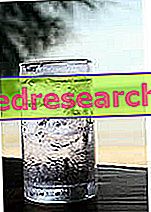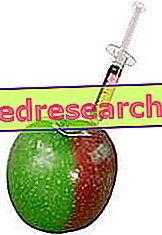Watch the video
X Watch the video on youtubeWater in the Human Body
Water is a very important nutrient for our body, so much so that in its absence death occurs within a few days.
Water in fact performs innumerable and vital functions:
It is an excellent solvent for numerous chemical substances;
regulates cell volume and body temperature;
promotes digestive processes;
it allows the transport of nutrients and the removal of metabolic waste.
Quantitatively water is the main constituent of the organism. In a medium-sized adult man (70 kg) it represents approximately 60% of the body weight, that is about 40 kg.

The water present in our body is divided into two compartments, the intracellular (2/3 of the total volume) and the extracellular (including the plasma, lymph, interstitial and cefalorachidian fluid).
The body's liquid compartments are separated from each other by semi-permeable membranes. The plasma, for example, is separated from the interstitial fluid through the walls of the blood vessels. Instead, cell membranes prevent direct contact between the interstitial and the intracellular fluid.
For the organism it is in fact essential to maintain the volumetric homeostasis of the two compartments.
| Total body water as% of weight | |||
| Child | Man | Woman | |
| skinny | 80 | 65 | 55 |
| Normal | 70 | 60 | 50 |
| Fat | 65 | 55 | 45 |
The volume of the intracellular fluid depends on the concentration of the solutes in the interstitial one. Under normal conditions, the interstitial fluid and the intracellular fluid are isotonic, ie they have the same osmolarity. If the concentration of solutes was greater in the intracellular fluid the cell would swell by osmosis; in the opposite situation the cell would tend to shrink instead. Both circumstances would still be seriously detrimental to cellular structures.
The plasma volume, called volemia, must be kept constant also to guarantee a good cardiac function. In fact, if there is an increase in plasma volume, blood pressure increases (hypertension); on the contrary, in the presence of hypovolemia, pressure decreases, blood viscosity increases and the heart becomes tired.
To ensure the homeostasis of the intracellular and intravascular fluid volume, it is necessary to keep the body's water content constant. In order for this balance to occur, the balance between water revenue and expenditure must be balanced.

With very few exceptions, foods contain a significant amount of water.
| Average water content in different foods | |
| Amount of water (% of edible part) | FOOD |
| 0 | Oil, sugar |
| 2-10 | Biscuits, dried fruit (peanuts, walnuts, pine nuts), popcorn |
| 10-20 | Butter, flour, dried vegetables, honey, pasta |
| 20-40 | Cheese (grana, gruyere), bread, pizza |
| 40-60 | Fresh cheeses (dairy products), ice cream, cold cuts |
| 60-80 | Meat, fish, eggs |
| > 80 | Fresh fruit, vegetables and vegetables, milk |
The water balance is kept in balance through the regulation of the exits (modifying the volume of excreted urine) and through the control of the entrances (modifying the intake of water).
In basal conditions, about 60% of daily water loss occurs with urine. The increase in temperature and exercise, on the other hand, increase water losses through perspiration and insensitive perspiration.
To compensate for these exits the body reduces the volume of urine eliminated, increasing the secretion of the antidiuretic hormone (ADH) or vasopressin. This peptide, secreted by the posterior pituitary, acts at the renal level, where it promotes the reabsorption of water, thereby reducing its elimination with urine.
The regulation of income, on the other hand, takes place through the stimulation of thirst, which is activated when the volume decreases (dehydration) or when body fluids tend to become hypertonic (after a salty meal).
Dehydration
Dehydration, even if modest, is a dangerous condition for the body. A 7% decrease in total body water is in fact sufficient to endanger the survival of the individual.
Dehydration is dangerous for several reasons. First of all, in a dehydrated organism the mechanism of sweating is blocked, in order to save the little water left in the body. However, the lack of sweat secretion causes a considerable organic overheating, with negative repercussions on the hypothalamic thermoregulatory center (see heat stroke).
Moreover, in a dehydrated organism the volume is reduced, so that the blood circulates less well in the vessels, the heart becomes tired and in extreme cases, cardiovascular collapse can arise.
The causes of dehydration are many:
exposure to a dry and windy climate, not necessarily hot (even at low temperatures dehydration is in fact remarkable; the cold, for example, stimulates the elimination of water with urine. Moreover, in the mountains, more water is eliminated with breathing, since the vapor pressure of the expired air is higher than the environmental one).
Intense and prolonged exercise.
Repeated episodes of abundant vomiting and diarrhea (in the case of cholera the death of the individual occurs precisely because of the considerable water losses related to an unstoppable diarrhea).
Strong bleeding and burns.
Insufficient fluid intake (especially in the elderly, because they are less sensitive to thirst).
How much should you drink?
In general it is advisable to drink at least a liter and a half of water a day.
It is particularly important to increase water intake during the summer months and when doing sport, in order to recover the water lost through sweating.
To prevent dehydration when exercising, you need to drink before, during and after exercise. In particular, when exercise is prolonged water alone may not be sufficient. For this reason it is advisable to add a modest amount of carbohydrates and mineral salts (especially sodium, chlorine and potassium) to the drink. The concentration of carbohydrates in the drink must not be higher than 8%, to avoid increasing the osmolarity of the solution, with consequent recall of water inside the digestive tract (effect contrary to that hoped for). This minimum percentage is still important to supply glucose to the body, saving valuable hepatic and muscular glycogen reserves.



